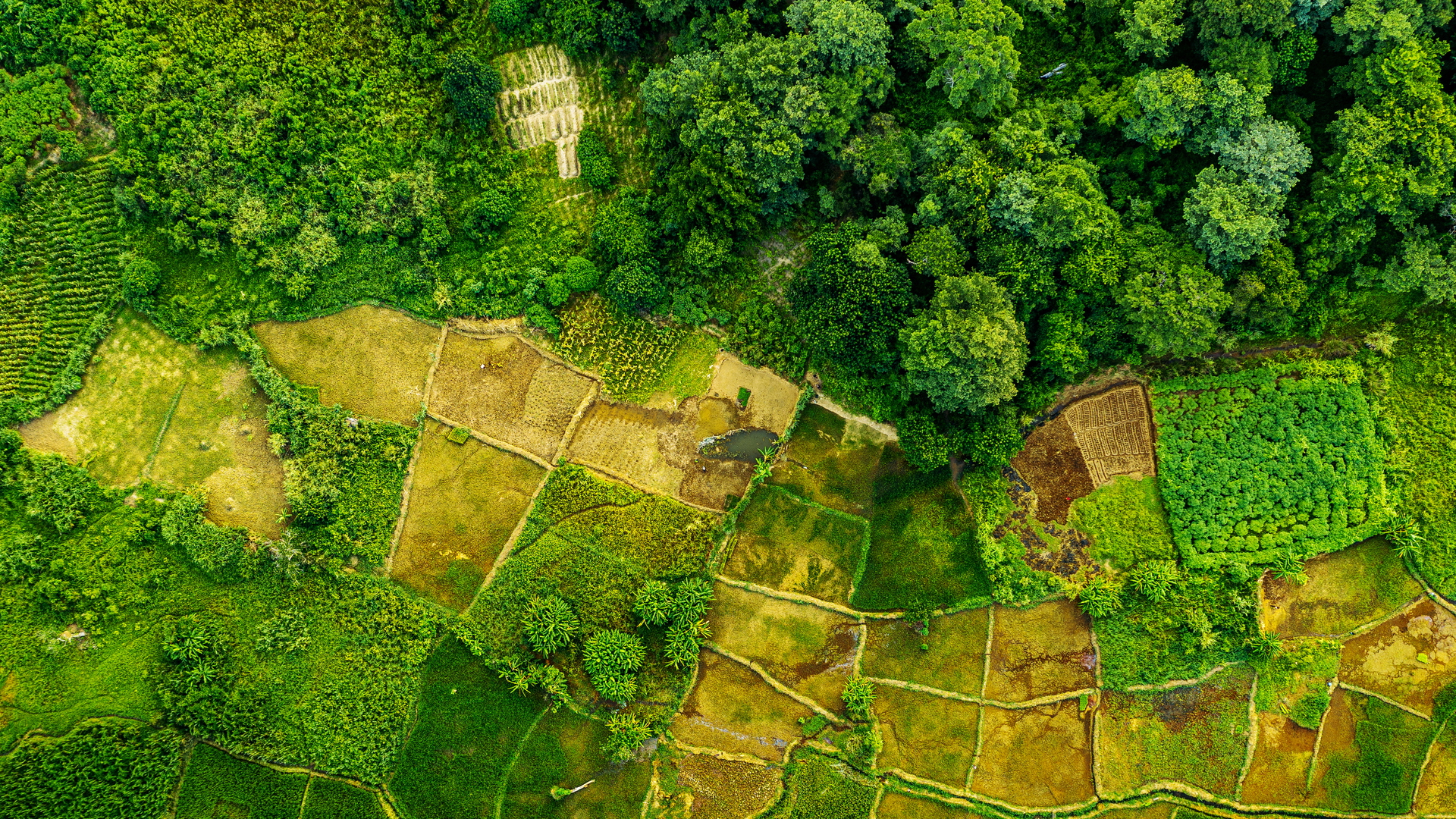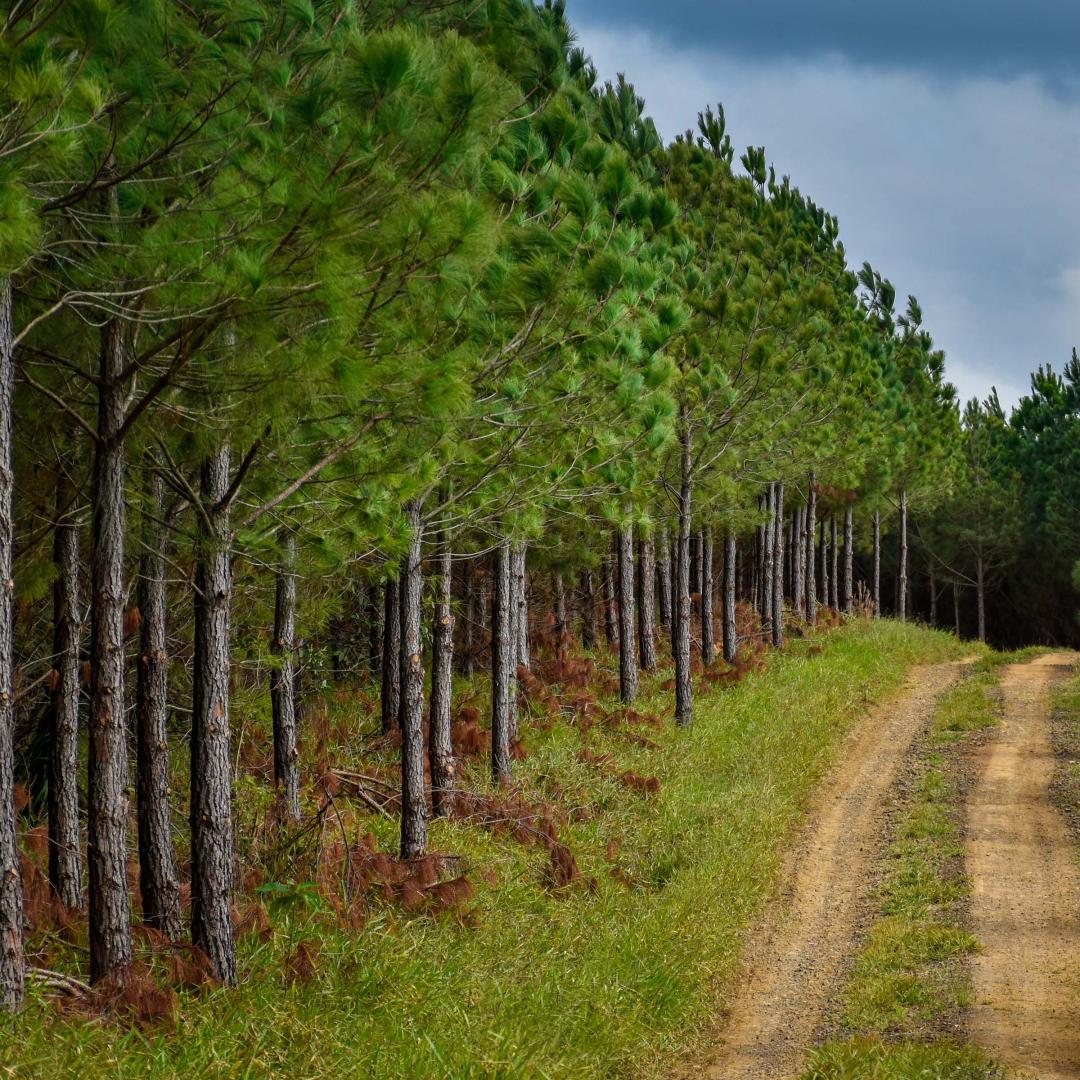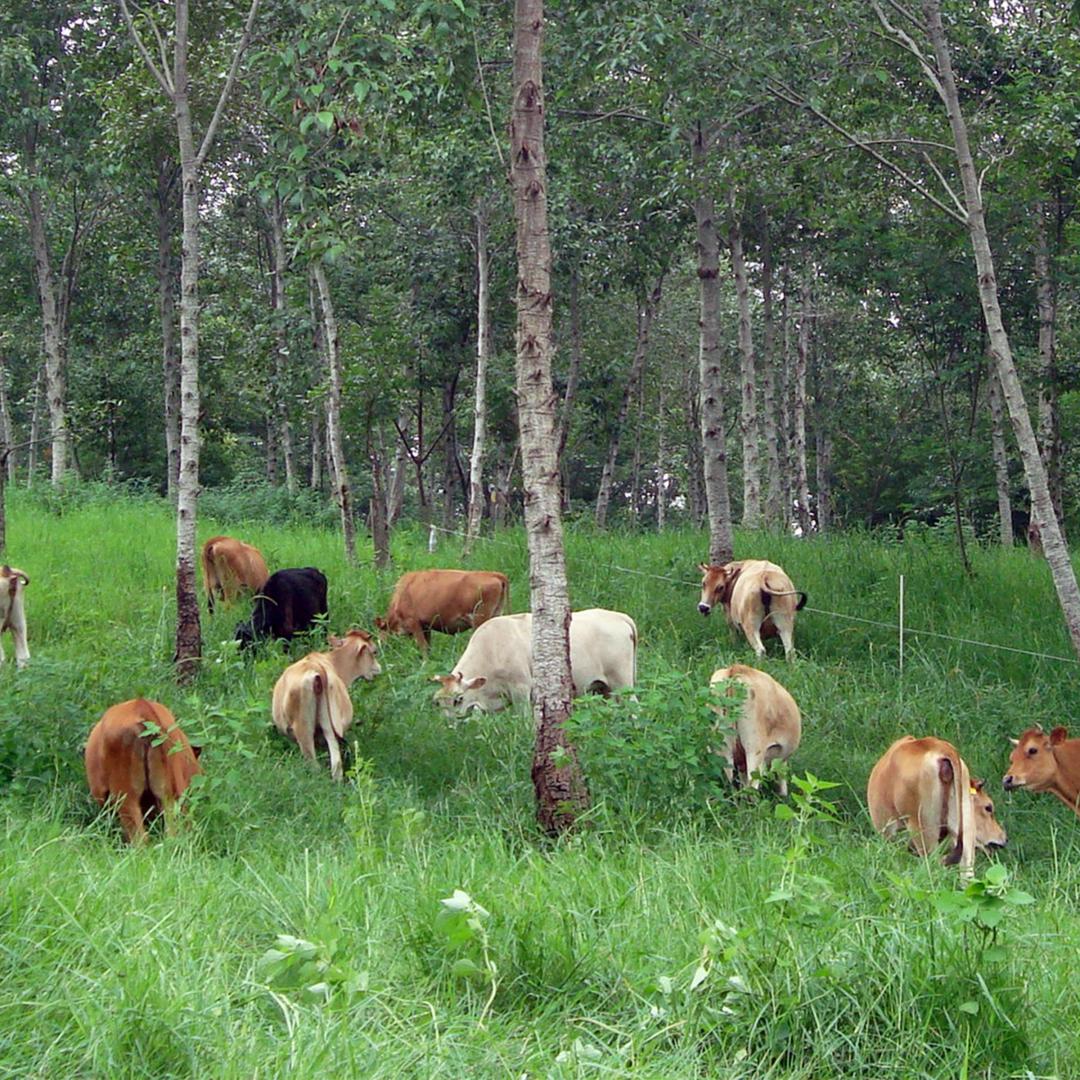Ansari, J., Udawatta, R. P., & Anderson, S. H. (2022). Soil nitrous oxide emission from agroforestry, rowcrop, grassland and forests in North America: a review. Agroforestry Systems, 97(8), 1465–1479. Link to source: https://doi.org/10.1007/s10457-023-00870-y
Basche, A., Tully, K., Álvarez-Berríos, N. L., Reyes, J., Lengnick, L., Brown, T., Moore, J. M., Schattman, R. E., Johnson, L. K., & Roesch-McNally, G. (2020). Evaluating the untapped potential of US conservation investments to improve soil and environmental health. Frontiers in Sustainable Food Systems, 4, 547876. Link to source: https://doi.org/10.3389/fsufs.2020.547876
Batcheler, M., Smith, M. M., Swanson, M. E., Ostrom, M., & Carpenter-Boggs, L. (2024). Assessing silvopasture management as a strategy to reduce fuel loads and mitigate wildfire risk. Scientific Reports, 14(1), 5954. Link to source: https://doi.org/10.1038/s41598-024-56104-3
Bentrup, G. & Shi, X. (in press). Multifunctional buffers: Design guidelines for buffers, corridors and greenways. USDA Forest Service.
Bostedt, G., Hörnell, A., & Nyberg, G. (2016). Agroforestry extension and dietary diversity–an analysis of the importance of fruit and vegetable consumption in West Pokot, Kenya. Food Security, 8, 271–284. Link to source: https://doi.org/10.1007/s12571-015-0542-x
Briske, D. D., Vetter, S., Coetsee, C., & Turner, M. D. (2024). Rangeland afforestation is not a natural climate solution. Frontiers in Ecology and the Environment. Link to source: https://doi.org/10.1002/fee.2727
Cadavid, Z., & BE, S. T. (2020). Sistemas silvopastoriles: aspectos teóricos y prácticos. CIPAV. Link to source: https://cipav.org.co/sdm_downloads/sistemas-silvopastoriles-aspectos-teoricos-y-practicos/
Cardinael, R., Umulisa, V., Toudert, A., Olivier, A., Bockel, L., & Bernoux, M. (2019). Revisiting IPCC Tier 1 coefficients for soil organic and biomass carbon storage in agroforestry systems. Environmental Research Letters, 13(12), 124020. Link to source: https://doi.org/10.1088/1748-9326/aaeb5f
Chapman, M., Walker, W.S., Cook-Patton, S.C., Ellis, P.W., Farina, M., Griscom, B.W., & Baccani, A. (2019). Large climate mitigation potential from adding trees to agricultural lands Global Change Biology, 26(80), 4357–4365. https://doi.org/10.1111/gcb.15121
Chatterjee, N., Nair, P. R., Chakraborty, S., & Nair, V. D. (2018). Changes in soil carbon stocks across the forest-agroforest-agriculture/pasture continuum in various agroecological regions: A meta-analysis. Agriculture, ecosystems & environment, 266, 55–67. Link to source: https://doi.org/10.1016/j.agee.2018.07.014
Damania, Richard; Polasky, Stephen; Ruckelshaus, Mary; Russ, Jason; Amann, Markus; Chaplin-Kramer, Rebecca; Gerber, James; Hawthorne, Peter; Heger, Martin Philipp; Mamun, Saleh; Ruta, Giovanni; Schmitt, Rafael; Smith, Jeffrey; Vogl, Adrian; Wagner, Fabian; Zaveri, Esha. (2023). Nature's Frontiers: Achieving Sustainability, Efficiency, and Prosperity with Natural Capital. Environment and Sustainable Development series. Washington, DC: World Bank Link to source: https://hdl.handle.net/10986/39453
de Sherbinin, A., VanWey, L. K., McSweeney, K., Aggarwal, R., Barbieri, A., Henry, S., Hunter, L. M., Twine, W., & Walker, R. (2008). Rural household demographics, livelihoods and the environment. Global Environmental Change, 18(1), 38–53. Link to source: https://doi.org/10.1016/j.gloenvcha.2007.05.005
Den Herder, M., Moreno, G., Mosquera-Losada, R. M., Palma, J. H., Sidiropoulou, A., Freijanes, J. J. S., & Burgess, P. J. (2017). Current extent and stratification of agroforestry in the European Union. Agriculture, Ecosystems & Environment, 241, 121–132. Link to source: https://doi.org/10.1016/j.agee.2017.03.005
Di Prima, S., Wright, E. P., Sharma, I. K., Syurina, E., & Broerse, J. E. W. (2022). Implementation and scale-up of nutrition-sensitive agriculture in low- and middle-income countries: A systematic review of what works, what doesn’t work and why. Global Food Security, 32, 100595. Link to source: https://doi.org/10.1016/j.gfs.2021.100595
deStefano, A, & Jacobson, M.G. (2018). Soil carbon sequestration in agroforestry systems: A review. Agroforestry Systems, 92, 285–299. Link to source: https://doi.org/10.1007/s13593-014-0212-y
Dudley, N., Eufemia, L., Fleckenstein, M., Periago, M. E., Petersen, I., & Timmers, J. F. (2020). Grasslands and savannahs in the UN Decade on Ecosystem Restoration. Restoration Ecology, 28(6), 1313–1317 Link to source: https://doi.org/10.1111/rec.13272
Dupraz, C, and Liagre, F.(2011). Agroforesterie: Des Arbres et des Cultures. Editions France Agricole. Link to source: https://agroboutique.com/agroecologie-catalogue/12-agroforesterie-des-arbres-et-des-cultures.html
FAO Statistical Service (2024). FAOStat. Link to source: https://www.fao.org/faostat/en/
Feliciano, D., Ledo, A., Hillier, J., & Nayak, D. R. (2018). Which agroforestry options give the greatest soil and above ground carbon benefits in different world regions?. Agriculture, ecosystems & environment, 254, 117–129. Link to source: https://doi.org/10.1016/j.agee.2017.11.032
Frelat, R., Lopez-Ridaura, S., Giller, K. E., Herrero, M., Douxchamps, S., Djurfeldt, A. A., Erenstein, O., Henderson, B., Kassie, M., Paul, B. K., Rigolot, C., Ritzema, R. S., Rodriguez, D., Van Asten, P. J. A., & Van Wijk, M. T. (2016). Drivers of household food availability in sub-Saharan Africa based on big data from small farms. Proceedings of the National Academy of Sciences of the United States of America, 113(2), 458–463. Link to source: https://doi.org/10.1073/pnas.1518384112
Garrett, H. E., Kerley, M. S., Ladyman, K. P., Walter, W. D., Godsey, L. D., Van Sambeek, J. W., & Brauer, D. K. (2004). Hardwood silvopasture management in North America. In New Vistas in Agroforestry: A Compendium for 1st World Congress of Agroforestry, 2004 (pp. 21–33). Springer Netherlands. Link to source: https://doi.org/10.1007/978-94-017-2424-1_2
Goracci, J., & Camilli, F. (2024). Agroforestry and animal husbandry. IntechOpen. Link to source: https://doi.org/10.5772/intechopen.1006711
Government of Colombia (2020). Actualización de la Contribución Determinada a Nivel Nacional de Colombia. Government of Colombia. Link to source: https://unfccc.int/sites/default/files/NDC/2022-06/NDC%20actualizada%20de%20Colombia.pdf
Greene, H., Kazanski, C. E., Kaufman, J., Steinberg, E., Johnson, K., Cook-Patton, S. C., & Fargione, J. (2023). Silvopasture offers climate change mitigation and profit potential for farmers in the eastern United States. Frontiers in Sustainable Food Systems, 7, 1158459. Link to source: https://doi.org/10.3389/fsufs.2023.1158459
Hart, D.R.T, Yeo, S, Almaraz, M, Beillouin, D, Cardinael, R, Garcia, E, Kay, S, Lovell, S.T., Rosenstock, T.S., Sprenkle-Hyppolite, S, Stolle, F, Suber, M, Thapa, B, Wood, S & Cook-Patton, S.C (2023). “Priority science can accelerate agroforestry as a natural climate solution”. Nature Climate Change. Link to source: https://doi.org/10.5281/zenodo.8209212
Husak, A. L., & Grado, S. C. (2002). Monetary benefits in a southern silvopastoral system. Southern Journal of Applied Forestry, 26(3), 159–164 Link to source: https://doi.org/10.1093/sjaf/26.3.159
IPCC (2019). Climate Change and Land: an IPCC special report on climate change, desertification, land degradation, sustainable land management, food security, and greenhouse gas fluxes in terrestrial ecosystems [P.R. Shukla, J. Skea, E. Calvo Buendia, V. Masson-Delmotte, H.-O. Pörtner, D. C. Roberts, P. Zhai, R. Slade, S. Connors, R. van Diemen, M. Ferrat, E. Haughey, S. Luz, S. Neogi, M. Pathak, J. Petzold, J. Portugal Pereira, P. Vyas, E. Huntley, K. Kissick, M. Belkacemi, J. Malley, (eds.)]. Link to source: https://www.ipcc.ch/srccl/
IPCC AR6 WG3 (2022). Climate Change 2022: Mitigation of Climate Change. Contribution of Working Group III to the Sixth Assessment Report of the Intergovernmental Panel on Climate Change [P.R. Shukla, J. Skea, R. Slade, A. Al Khourdajie, R. van Diemen, D. McCollum, M. Pathak, S. Some, P. Vyas, R. Fradera, M. Belkacemi, A. Hasija, G. Lisboa, S. Luz, J. Malley, (eds.)]. Cambridge University Press, Cambridge, UK and New York, NY, USA. Link to source: https://doi.org/10.1017/9781009157926
Jacobsen (2019). Secondary metabolites in leaf hay as a mitigation option for enteric methane production in ruminants. Aarhus University. Link to source: https://pure.au.dk/ws/portalfiles/portal/197235590/Secondary_Metabolites_in_Leaf_Hay_as_a_Mitigation_Option_for_Enteric_Methane_Production_in_Ruminants.pdf
Jose, S., & Dollinger, J. (2019). Silvopasture: a sustainable livestock production system. Agroforestry systems, 93, 1-9. Link to source: https://doi.org/10.1007/s10457-019-00366-8
Lal, R., Smith, P., Jungkunst, H. F., Mitsch, W. J., Lehmann, J., Nair, P. R., & Ravindranath, N. H. (2018). The carbon sequestration potential of terrestrial ecosystems. Journal of soil and water conservation, 73(6), 145A–152A. Link to source: https://doi.org/10.2489/jswc.73.6.145A
Lee, S., Bonatti, M, Löhe, K, Palacios, V., Lana, M.A., and Sieber, S (2020). Adoption potentials and barriers of silvopastoral systems in Colombia: Case of Cundinamarca region. Cogent Environmental Science 6(1). Link to source: https://doi.org/10.1080/23311843.2020.1823632
Lemes, A. P., Garcia, A. R., Pezzopane, J. R. M., Brandão, F. Z., Watanabe, Y. F., Cooke, R. F., Sponchiado, M., Paz, C. C. P., Camplesi, A. C., Binelli, M., & Gimenes, L. U. (2021). Silvopastoral system is an alternative to improve animal welfare and productive performance in meat production systems. Scientific Reports, 11(1), 14092. Link to source: https://doi.org/10.1038/s41598-021-93609-7
Lorenz, K., & Lal, R. (2018). Carbon sequestration in agricultural ecosystems. Springer, Cham. Link to source: https://link.springer.com/book/10.1007/978-3-319-92318-5
Mehrabi, Z., Tong, K., Fortin, J., Stanimirova, R., Friedl, M., & Ramankutty, N. (2024). Global agricultural lands in the year 2015. Earth System Science Data Discussions, 2024, 1–44. Link to source: https://doi.org/10.5194/essd-2024-279
Montagnini, F (2019). Función de los sistemas agroforestales en la adaptación y mitigación del cambio climático. Sistemas agroforestales: Funciones productivas, socioeconómicas y ambientales, 269-299. Link to source: https://cipav.org.co/wp-content/uploads/2020/08/sistemas-agroforestales-funciones-productivas-socioeconomicas-y-ambientales.pdf
Morena, G., & Rolo, V. (2019). Agroforestry practices: Silvopastoralism. In Agroforestry for sustainable agricultura (1st ed.). Burleigh Dodds Science Publishing. Link to source: https://doi.org/10.1201/9780429275500
Murgueitio, E., Uribe, F., Molina, C., Molina, E., Galindo, W., Chará, J., & González, J. (2016). Establecimiento y manejo de sistemas silvopastoriles intensivos con Leucaena. Editorial CIPAV, Cali, Colombia. Link to source: https://www.researchgate.net/profile/Juan-Naranjo-R/publication/310460876_Establecimiento_y_manejo_de_sistemas_silvopastoriles_intensivos_con_leucaena/links/582e30cb08ae138f1c01d8b9/Establecimiento-y-manejo-de-sistemas-silvopastoriles-intensivos-con-leucaena.pdf
Nair, P.K. R. (2012). Climate change mitigation: A low-hanging fruit of agroforestry. Agroforestry: The future of global land use, 31–69. Link to source: https://doi.org/10.1007/978-94-007-4676-3_7
Ortiz, J., Neira, P., Panichini, M., Curaqueo, G., Stolpe, N. B., Zagal, E., & Gupta, S. R. (2023). Silvopastoral systems on degraded lands for soil carbon sequestration and climate change mitigation. Agroforestry for Sustainable Intensification of Agriculture in Asia and Africa, 207–242. Link to source: https://doi.org/10.1007/978-981-19-4602-8_7
Pent, G. J. (2020). Over-yielding in temperate silvopastures: a meta-analysis. Agroforestry Systems, 94(5), 1741–1758. Link to source: https://doi.org/10.1007/s10457-020-00494-6
Pezo, D., Ríos, N., Ibrahim, M., & Gómez, M. (2018). Silvopastoral systems for intensifying cattle production and enhancing forest cover: the case of Costa Rica. Washington, DC: World Bank. Link to source: https://www.profor.info/sites/default/files/Silvopastoral%2520systems_Case%2520Study_LEAVES_2018.pdf
Poudel, S., Pent, G., & Fike, J. (2024). Silvopastures: Benefits, past efforts, challenges, and future prospects in the United States. Agronomy, 14(7), 1369. Link to source: https://doi.org/10.3390/agronomy14071369
Quandt, A, Neufeldt, G, & Gorman, K (2023). Climate change adaptation through agroforestry: Opportunities and gaps. Current Opinion in Environmental Sustainability. 60, 101244. Link to source: https://doi.org/10.1016/j.cosust.2022.101244
Rivera, J. E., Serna, L., Arango, J., Barahona, R., Murgueitio, E., Torres, C. F., & Chará, J. (2023). Silvopastoral systems and their role in climate change mitigation and Nationally Determined Contributions in Latin America. In Silvopastoral systems of Meso America and Northern South America (pp. 25–53). Cham: Springer International Publishing. Link to source: https://doi.org/10.1007/978-3-031-43063-3_2
Rojas, D, & Rodriguez Anido, N. (2022) Potential of silvopastoral systems for the mitigation of greenhouse gasses generated in the production of bovine meat. In Sistemas silvopastoriles: Hacia una diversificación sostenible. CIPAV. Link to source: https://cipav.org.co/sistemas-silvopastoriles-hacia-una-diversificacion-sostenible/
Riset, J.Å., Tømmervik, H. & Forbes, B.C. (2019). Sustainable and resilient reindeer herding. Reindeer Caribou Health Dis, (23–43). Link to source: https://www.researchgate.net/publication/344787755_Ch13_Sustainable_and_resilient_reindeer_herding
Shelton, M., Dalzell, S., Tomkins, N. and Buck, S. R. (2021). Leucaena: The productive and sustainable forage legume. University of Queensland. Link to source: https://era.dpi.qld.gov.au/id/eprint/9425/
Shi, L., Feng, W., Xu, J., & Kuzyakov, Y. (2018). Agroforestry systems: Meta‐analysis of soil carbon stocks, sequestration processes, and future potentials. Land Degradation & Development, 29(11), 3886–3897. Link to source: https://doi.org/10.1002/ldr.3136
Smith, M. M., Bentrup, G., Kellerman, T., MacFarland, K., Straight, R., Ameyaw, L., & Stein, S. (2022). Silvopasture in the USA: A systematic review of natural resource professional and producer-reported benefits, challenges, and management activities. Agriculture, Ecosystems & Environment, 326, 107818. Link to source: https://doi.org/10.1016/j.agee.2021.107818
Sprenkle-Hyppolite, S. Griscom, B., Griffey, V., Munshi, E., Chapman, M. (2024). Maximizing tree carbon in cropland and grazing lands while sustaining yields. Carbon Balance and Management 19:23. Link to source: https://doi.org/10.1186/s13021-024-00268-y
Toensmeier, E. (2017). Perennial staple crops and agroforestry for climate change mitigation. Integrating landscapes: Agroforestry for biodiversity conservation and food sovereignty, 439-451. Link to source: https://doi.org/10.1007/978-3-319-69371-2_18
U.S. Department of Agriculture Natural Resources Conservation Service [USDA NRCS]. (2025). Conservation Practice Physical Effects [Dataset]. Link to source: https://www.nrcs.usda.gov/resources/guides-and-instructions/conservation-practice-physical-effects
Udawatta, R. P., Walter, D., & Jose, S. (2022). Carbon sequestration by forests and agroforests: A reality check for the United States. Carbon footprints, 1(8). Link to source: https://doi.org/10.20517/cf.2022.06
Zeppetello, L. R. V., Cook-Patton, S. C., Parsons, L. A., Wolff, N. H., Kroeger, T., Battisti, D. S., Bettles, J., Spector, J. T., Balakumar, A., & Masuda, Y. J. (2022). Consistent cooling benefits of silvopasture in the tropics. Nature communications, 13(1), 708. Link to source: https://doi.org/10.1038/s41467-022-28388-4
Zhu, X., Liu, W., Chen, J., Bruijnzeel, L. A., Mao, Z., Yang, X., Cardinael, R., Meng, F.-R., Sidle, R. C., Seitz, S., Nair, V. D., Nanko, K., Zou, X., Chen, C., & Jiang, X. J. (2020). Reductions in water, soil and nutrient losses and pesticide pollution in agroforestry practices: A review of evidence and processes. Plant and Soil, 453(1–2), 45–86. Link to source: https://doi.org/10.1007/s11104-019-04377-3





